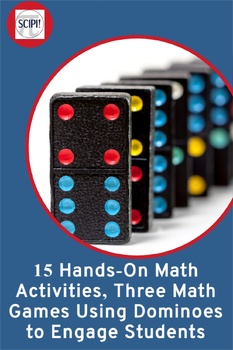15 Hands-On Math Activities Three Math Games Using Dominoes to Engage Students
- PDF
Description
This math resource uses dominoes as a manipulative for activities that include four-digit place value, using the commutative property, problem solving, reducing proper and improper fractions and practicing multiplication and division facts. The domino games involve finding sums, using greater than, less than, and equal signs, and ordering fractions.
While some of the domino activities use games for review, the other activities extend, enhance, or introduce a new math concept. The activities and games vary in difficulty; so, differentiated instruction is easy. This resource is also excellent for math center activities. So, engage your students and improve their math skills with this creative resource.
For these 15 activities and three games, commercial sets of dominoes may be used, or you can copy the blackline which is provided in the resource. You should have at least one set of 28 dominoes for every two children.
To view examples from this resource as well as a complete Table of Contents, download the preview or FREE Version:
Also available is a domino resource for the primary grades:
If you would like just games that use dominoes, check out this resource.





